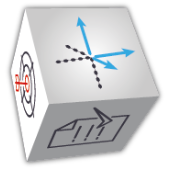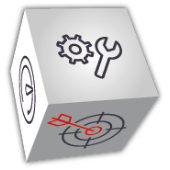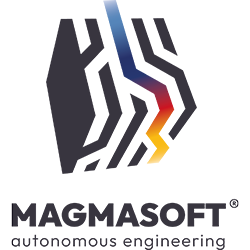
The unique MAGMA APPROACH, which is fully integrated into MAGMASOFT®, is a systematic methodology for reaching desired goals by performing simulations as virtual experiments and put them into action. This methodology helps to simplify complex technical challenges and systematically address them using the appropriate engineering tools available in MAGMASOFT®.
The MAGMA APPROACH provides metal casters, toolmakers and casting users with a new and more efficient means to realize cost reduction and value creation throughout their entire operation. In combination with MAGMASOFT®’s Autonomous Engineering™, the MAGMA APPROACH establishes optimized and robust casting and tooling designs and process parameters before production has even begun.
At any stage of product development or improvement processes, the MAGMA APPROACH will guide the MAGMASOFT® user through the following steps:
The first step in the MAGMA APPROACH is to define objectives. The objectives can be any quality, cost, or production driven targets that will be used to determine the best possible designs or process parameters. This can often include the balancing of competing objectives such as reducing shrinkage porosity while achieving the smallest riser size.

Examples:
- Set up a reliable gating and risering or tool design that produces castings to an acceptable quality level
- Identify the best compromise between your quality and yield
- Determine which parameters have a significant impact on existing casting defects
- Improve casting productivity or cycle times
- Identify optimized operating ranges for process parameters in any casting process
- Find a robust process window that takes into account common process variability that occurs in manufacturing processes
After determining which objectives are key to success, the next step is to decide which variables to define in an effort to achieve the goals that have been set. Variables can include the variation of any casting or tool dimensions, process parameters or materials.

Examples:
- Parametric variation of feeder size, casting geometry or chill location
- Systematic modification of gating system dimensions and shapes
- Process variation such as pouring temperatures, filling conditions or shakeout times
- Modification of alloy composition and metallurgical treatment
- Variation of cooling line and heating device positions
The software allows for the specification of one or more quality criteria or cost related parameters to assess the results of the investigation in a quantitative manner.

Examples:
- Casting quality including porosity, inclusions, cracks, and casting distortion
- Required local microstructures and mechanical properties
- Productivity parameters, such as shake out times, production speed or cycle times
- Cost and resource management such as casting yield or thermal die balancing
Now that the complex technical challenge has been simplified by defining objectives, variables to investigate, and key criteria to measure, the engineer will begin utilizing different “tools” available in MAGMASOFT® that will ensure that the required tasks are performed as efficiently as possible. There are many different features in MAGMASOFT® to minimize computational efforts and project set up times. The fully automated simulation set-up loop in MAGMASOFT® reduces engineering time substantially.

Examples:
- Easy use of any CAD geometry including built-in parametric modeling
- Access to a database of pre-made parametric riser and gating geometries
- Automated meshing of any complex shaped project in seconds
- Fully autonomous simulation set up loop for running multiple designs
- Constraints can be applied to limit the required number of simulations
- Automated result evaluation and focused assessment of virtual experiments
- Effective statistical tools to reduce the number of virtual experiments required
Autonomous Engineering™ with MAGMASOFT® offers different strategies to reach the defined goals. These strategies include running individual simulations, setting up a virtual Design of Experiments to test different variables that are of interest, or performing a comprehensive Autonomous Optimization, which uses genetic algorithms. Each, or a combination of these strategies, are used by the engineer based on the technical challenge to be addressed.

Examples:
- The freedom to run a single simulation, a parameter study or an Autonomous Optimization at any stage of the development process
- Provides decision making tools to investigate a process window with a given set of variables
- Supports inverse optimization to determine process conditions or material properties from measurements
The final step is to take action based on the insight MAGMASOFT® has provided. This may include cutting tooling based on optimized casting or rigging designs, educating different personnel about the importance of different process variables that have been shown to be critical, or defining ranges for different process variables to ensure a robust SOP and a stable production process. The built-in evaluation and assessment tools facilitate effective communication between different personnel in your company and with your customers.

Examples:
- A comprehensive suite of assessment tools assess data efficiently to gain a better understanding of the impact that each design and process parameter has on casting quality, costs and production efficiencies
- Assessment tools ensure that data is used effectively to eliminate defects
- The use of quantitative metrics facilitate standardized decision-making processes
- Easy to understand charts and graphs aid in effectively explaining and understanding root causes for quality issues and how to control them
- The use of quantitative data supports continuous improvement processes during production

By means of Autonomous Engineering, simulations with MAGMASOFT ® can be used in an automated virtual test plan to pursue different quality and cost objectives simultaneously.